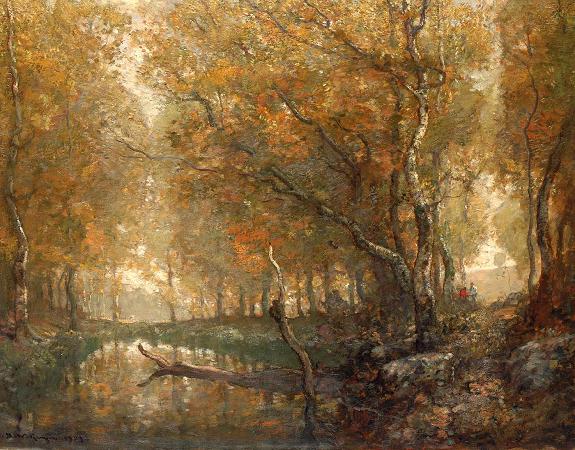
Landscape with Pond. A pond is an area filled with water, either natural or artificial, that is smaller than a lake.
Defining them to be less than 5 hectares in area, less than 5 meters deep, and with less than 30% emergent vegetation helps in distinguishing their ecology from that of lakes and wetlands. Ponds can be created by a wide variety of natural processes, or they can simply be isolated depressions filled by runoff, groundwater, or precipitation, or all three of these.
They can be further divided into four zones: vegetation zone, open water, bottom mud and surface film. The size and depth of ponds often varies greatly with the time of year; many ponds are produced by spring flooding from rivers.
Ponds may be freshwater or brackish in nature. 'Ponds' with saltwater, with a direct connection to the sea that maintains full salinity, would normally be regarded as part of the marine environment because they would not support fresh or brackish water organisms, so not really within the realm of freshwater science.
Ponds are usually by definition quite shallow water bodies with varying abundances of aquatic plants and animals. Depth, seasonal water level variations, nutrients fluxes, amount of light reaching the ponds, the shape, the presence of visiting large mammals, the composition of any fish communities and salinity can all affect the types of plant and animal communities present. Food webs ar
Defining them to be less than 5 hectares in area, less than 5 meters deep, and with less than 30% emergent vegetation helps in distinguishing their ecology from that of lakes and wetlands. Ponds can be created by a wide variety of natural processes, or they can simply be isolated depressions filled by runoff, groundwater, or precipitation, or all three of these.
They can be further divided into four zones: vegetation zone, open water, bottom mud and surface film. The size and depth of ponds often varies greatly with the time of year; many ponds are produced by spring flooding from rivers.
Ponds may be freshwater or brackish in nature. 'Ponds' with saltwater, with a direct connection to the sea that maintains full salinity, would normally be regarded as part of the marine environment because they would not support fresh or brackish water organisms, so not really within the realm of freshwater science.
Ponds are usually by definition quite shallow water bodies with varying abundances of aquatic plants and animals. Depth, seasonal water level variations, nutrients fluxes, amount of light reaching the ponds, the shape, the presence of visiting large mammals, the composition of any fish communities and salinity can all affect the types of plant and animal communities present. Food webs ar
Wikipedia ...